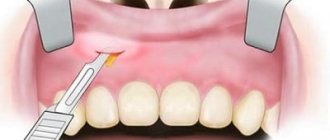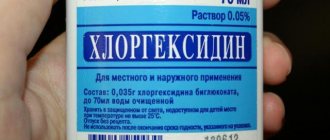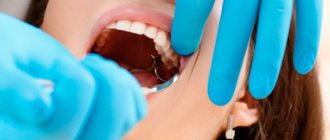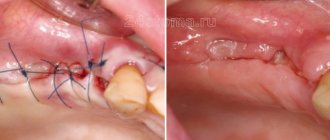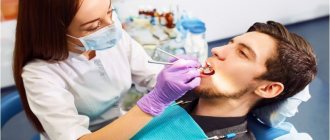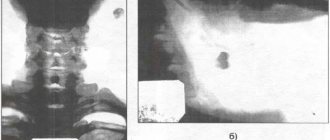After surgical extraction of a tooth and the appearance in the mouth of a natural wound for this situation - a hole, almost everyone has a desire to help the healing process in every possible way, to protect the wound from the proliferation of pathogenic bacteria. After all, more than once in our lives, each of us has heard terrifying stories from relatives and friends about how they suffered and struggled with the inflammatory process that arose after the same operation. In addition, until quite recently, every dental surgeon, after removing a tooth, warned the patient about the need to rinse, and the fact that today most of them are silent about this seems to us, at a minimum, to be unprofessional. We hasten to reassure you - the whole point is only a revaluation of approaches to understanding natural healing processes. Let's look in more detail in which cases rinsing can be beneficial and in which it can be harmful, and how to rinse the mouth after tooth extraction.
A complete overview of the useful product: scope, rules of use and main indications
Even simple tooth extraction inevitably leads to tissue trauma. Therefore, after the procedure, it is very important to follow the doctor’s recommendations to prevent infection of the open wound, inflammation of surrounding tissues and the development of other complications. One of the main aspects of prevention during the rehabilitation period is maintaining hygiene with regular antiseptic treatment of the oral cavity. For this purpose, specialists usually prescribe antibacterial solutions for rinses and mouth baths, for example, Chlorhexidine. Further in the article, read about the indications for use of the product, its pros and cons, precautions, as well as how to properly rinse your mouth with Chlorhexidine after tooth extraction.
Features of care during the operation of structures
After installing crowns or bridges, you need to care for teeth on implants in the same way as your own, but even more carefully:
- in addition to brushes and pastes, use irrigators for high-quality cleaning of hard-to-reach places;
- regularly carry out professional hygiene procedures in the dentist’s office;
- visit a specialist once every six months to check the condition of the implants and orthopedic structures installed on them.
The service life of artificial roots primarily depends on the quality of their care and compliance with the doctor’s recommendations. If the patient does everything correctly, artificial roots can last him a lifetime.
"Chlorhexidine" - what is this drug and when is it indicated for use?
We are talking about one of the most effective and at the same time financially affordable drugs with an antibacterial effect. This is a disinfectant solution, the action of which is aimed at combating pathogenic microflora - fungal or bacterial etiology. The use of the product in dentistry provides high-quality antiseptic treatment of the mucous membrane and teeth during or after treatment of pathological conditions, with cuts and trauma to oral tissues, after tooth extraction, including complex extraction of wisdom teeth, as well as after any other surgical interventions. The drug is indicated for use at any age, including children and women during pregnancy, but only as prescribed by a doctor.
The solution is a clear, almost odorless liquid. The drug is based on the active substance – chlorhexidine bigluconate. Chlorhexidine is available in different forms: spray, solution or vaginal suppositories. At the same time, the spray and solution are also used to disinfect skin and medical instruments. The active component is effective against most pathogenic microorganisms, various viruses and yeasts.
The drug is produced in various forms
Frequently asked questions and answers
Don't worry: it's completely normal to feel some discomfort. But be sure to pay attention to the signals your body sends. If in doubt, contact support to find out if your symptoms are normal. Be attentive to your teeth and your body as a whole - remember that implants, the entire jaw system, and you yourself need some time for rehabilitation.
Postoperative consequences and complications
This section discusses the most popular questions about conditions that arise during or in the first days after the installation of implants. Please note that it is very important to distinguish between the concepts of “consequences” (this is the norm, since tissue injury occurs during surgery) and “complications” (they are a pathological condition that requires immediate consultation with a doctor).
During the operation, I heard the doctors and felt that they were doing something in my mouth, although without pain, but I should have been sleeping, why?
You need to understand the difference between concepts such as “sedation” and “general anesthesia.”
General anesthesia is a complete shutdown of consciousness and the patient's immersion in sleep. As a rule, it is carried out by inhalation. Breathing is provided by an artificial lung ventilation device (ALV). Therefore, when using general anesthesia, the patient does not hear or feel anything. Sedation can be xenon (superficial, essentially to calm and saturate the body’s cells with oxygen), as well as intravenous. In the second case, certain anesthetics are introduced into the body (selected individually), their dosage is calculated based on the patient’s weight, his state of health, and the duration of the procedure. If necessary, the drug can be reintroduced during surgery. At the same time, local anesthesia is used.
The Smile-at-Once Clinic has an agreement with a specialized and licensed service of professional anesthesiologists. The ambulance and the team of doctors are certified within the framework of the standards and are an ambulance substation. Therefore, treatment under general anesthesia and intravenous sedation is carried out under the strict supervision of specialized specialists.
The difference between sedation and general anesthesia is that the patient retains the ability to breathe on his own, there are no involuntary reflexes of the respiratory tract (coughing, swallowing), unlike anesthesia, the patient is conscious and can, if necessary, follow the doctor’s instructions.
Since sedation uses more gentle drugs (unlike general anesthesia), the patient does not fall asleep, but relaxes. The action is individual: someone falls asleep for several hours, someone plunges into a state of complete relaxation. If you belong to the second type, then you will really feel everything that happens in the oral cavity. But all procedures are painless, since high-quality local anesthesia is used. And the sensations remain at the level of “moving instruments” in the oral cavity.
I just returned home from implantation and my cheek started to swell. Is this normal and what can I do?
This is a normal process caused by tissue trauma during implant installation. The swelling reaches its peak on the 3rd day, after which it should gradually subside. If the situation is opposite, be sure to consult a doctor. To reduce swelling, you need to apply a cold compress for the first two hours, repeating the course throughout the day if necessary.
The wound bleeds even several hours after the operation. This is fine?
If the bleeding is minor, there is nothing to worry about. You can stop it by applying a piece of sterile gauze to the wound and closing your jaws tightly. Remember not to rinse your mouth, actively move your jaw, chew, suck or swallow forcefully - all of this can increase bleeding.
If 3-5 hours after surgery the bleeding not only does not decrease, but also intensifies, you need to consult a doctor.
Yesterday I had an operation, and today I woke up with blood on my pillow, and the bleeding appears periodically throughout the day, what should I do?
Occasional bleeding is normal up to 7 days after surgery, but usually goes away within 2-3 days. We strongly recommend sleeping in a horizontal position right away, with pillows on the sides of your head. If necessary, make a comfortable tilt angle of up to 30 degrees for yourself.
It is important to sleep strictly on your back, but if you accidentally turned your face to the side in your sleep and were in this position for a long time, then due to tissue compression, bleeding is possible, and depending on the load, even profuse bleeding. The main thing is that it stops within 1-2 hours after you take a vertical position. If the bleeding is persistent, be sure to contact Patient Services to arrange an unscheduled examination by your physician.
I feel uncomfortable in the lying position, I feel pressure in the jaw area and pulsation in my head. What to do?
Such sensations arise due to increased blood flow to the head. In this situation, try sleeping in a semi-sitting position (tilt up to 30 degrees) - use an additional pillow or place it under the mattress, increasing the inclination of the bed. This way the head will be at a higher level in relation to the body and the unpleasant sensations will subside. But it is advisable to fix your head so as not to throw it to the side.
I had bruises on my face – hematomas. Is this normal and how can I remove them?
Hematomas are a consequence of vascular injury during implant installation. They appear quite often after the installation of two-piece structures, as well as after zygomatic implants - they appear approximately 2-3 days after the operation. You have absolutely nothing to worry about - the color of the bruises will change as the tissue begins to recover. In the fight against swelling and bruises, various gels for resolving bruises, for example Badyaga Forte, will help you.
My lips are dry and have small cracks - what does this mean?
This is also a completely normal condition caused by a long stay in the dentist's chair and the lack of natural wetting of the mucous membranes. For the first two to three days, use petroleum jelly or a cream containing lanolin to relieve dry lips. A regular balm may not be enough - you need a cream that is as rich and moisturizing as possible. Also make sure you drink enough fluids.
I have increased salivation after having implants - is this normal?
Saliva is a very important biological medium for the organs and tissues of the oral cavity. It contains many enzymes that promote normal digestion and the formation of healthy oral microflora. The therapeutic norm is the production of liquid by saliva in the amount of 2 ml per ten minutes. In the case of implantation, especially during the period when the denture has not yet been installed, the patient may complain of hyperactivation of the secretory function of the salivary glands already when 5 ml is produced. This is a normal reaction to tissue injury as a result of implantation, especially if the operation was performed to restore a full row of teeth.
But increased salivation is also possible as a result of damage to the lingual nerve. Its symptoms are pain when swallowing, changes or complete loss of taste, numbness of the tongue and its biting, burning, drooling. If the integrity of the nerve is not compromised, but there is compression on the nerve or its sheath is damaged, then the unpleasant sensations are restored within a period of 7 days to 4 months. Otherwise, more time may be required for rehabilitation, and in case of extensive disruption of the integrity of the nerve bundle, microsurgical interventions may be required.
Failures in the functioning of the endocrine system are another common cause of hypersalivation. Usually, problems with the thyroid gland are to blame. The symptom can also be triggered by diabetes mellitus or hormonal changes - during menopause or puberty.
Part of my face is numb, it’s difficult to talk and open my mouth, does this mean that the nerve is damaged and how long will these sensations last?
Numbness is caused by compression of the trigeminal nerve, its stretching, or injury - complete or partial intersection. In the case of sprain or compression without compromising the integrity of the trigeminal nerve, the sensations pass quite quickly - within up to 7 days as blood circulation in the bone tissue improves. But if there was partial damage to the fibers of the nerve bundle, then the rehabilitation process can take from 14 days to 6 months. In cases of severe trauma, implants may need to be reinstalled because the body of the implant interferes with the restoration of axons (processes) in the nerve bundles.
According to research, damage to the trigeminal nerve during dental implantation occurs in no more than 3% of patients, while only 1.7% are diagnosed with permanent neuropathy, requiring microsurgical correction of the situation.
In our clinic, before the operation, careful computer planning of the placement of implants is carried out, after which surgical templates are printed, protecting the patient and the doctor from incorrect installation of implants. Immediately or the next day after the operation, a control computed tomography is performed, on which a control commission (consilium of doctors), in accordance with international quality assessment protocols, compares the placement of implants with the original plan and makes a conclusion about the success of the operation, or makes recommendations to the attending physician on the need to take additional measures
Please note that there is no point in hiding the fact of damage to the trigeminal nerve for the doctor and the clinic; it will reveal itself anyway - this is the first thing. Secondly, even if this happened, the consequences are eliminated by properly selected therapy and joint work between the doctor and the patient.
Yes, if damage occurs, then the patient will have to undergo quite a long period of rehabilitation (up to 6 months), but in difficult clinical situations of complete absence of teeth and low quality bone tissue, the doctor works in very limited conditions, so, unfortunately, some consequences but not life-threatening and health dysfunction cannot always be avoided.
Do not confuse nerve damage with compression on it that occurs in the bone as a result of swelling after the installation of implants located close to the nerve endings. Compression goes away along with swelling and numbness in this situation is a normal reaction.
Most often, such symptoms typically appear 2-3 days after multiple implantations; they are a normal reaction to tissue injury when screwing in implants and damage to intraosseous capillaries. Improvements will be noticeable almost immediately after installing the prosthesis on the implants and activating the chewing load, and with it the restoration and blood circulation in the bones.
How long does it take for wounds to heal after implantation and for implants to take root?
The first phase is the healing of soft tissues. It takes about a week. Already after this stage you will feel much better. If the installation of implants was carried out in a minimally invasive way - using a protocol, then rehabilitation takes only 2-3 days. The second phase is osseointegration, that is, the direct engraftment of the implant into the bone tissue. It takes from 3 months to six months, in difficult situations up to 8-12 months - during this time the bone actively grows around the implants, strengthening their position.
Is it necessary to take antibiotics after implantation?
Antibacterial drugs are prescribed during major surgery in order to reduce the risk of developing inflammatory processes. In addition, they are mandatory for those patients in whom implantation was carried out against the background of periodontitis or inflammatory processes in periodontal tissues (cysts, granulomas, etc.) were diagnosed before the installation of implants. In other cases, you can limit yourself to vitamins, local anti-inflammatory drugs and antihistamines.
How normal is discharge from a postoperative wound?
If you had bone material or an RPF membrane grafted, if the doctor used healing drugs (for example, Alvostat), you should not panic - discharge from the wound in such situations is normal. But we still recommend that you contact support and discuss the nature of the discharge with your doctor.
Can stitches come apart after implants are installed?
This is a fairly rare phenomenon, the main reasons for which are excessive stress on the operated area, frequent touching of the wound with the tongue, and failure to comply with hygiene rules. As a rule, we use resorbable threads (dissolve on their own) - such sutures do not need to be removed. But in any case, after installing the implants, you will still visit the implantologist in the coming days - the attending physician will monitor your condition.
My temperature is elevated, it’s shocking. Do I need to see a doctor?
An increase in body temperature up to 39° in the first 3 days is a completely normal reaction of the body to external influences and the entry of a foreign body (in this case, an implant). It should not cause concern - in this way our body accelerates all tissue repair processes. But if the temperature subsided, you felt well, and then there was a sharp increase to 38-39°, you should immediately consult a doctor.
To drink or not to drink antipyretics - you must decide for yourself, based on your own well-being. Monitor your condition as each person handles fever differently.
Questions related to prosthetics
When implantation is carried out according to immediate loading protocols, the prostheses are installed immediately - within 3-4 days maximum. At first, you will experience some discomfort - and this is completely normal, because before treatment you lived for a long time without teeth, your bite has changed. Now it just takes time for both you and your jaw system to get used to the changes.
I'm not very comfortable chewing and talking with my new denture. Is this normal and how can I fix the situation?
Yes, it is normal. You haven’t had teeth for a long time, so the muscles have atrophied, the temporomandibular joint is used to functioning differently, so it takes time to adapt - you will get used to it. Due to the lack of teeth, the position of your tongue has also changed - it has adapted to the situation, so after installing the prosthesis, you experience difficulty pronouncing some sounds.
I have problems with diction after prosthetics, I have a lisp and cannot pronounce sounds, how can I fix this?
To restore your diction, pronounce tongue twisters and speak as much as possible. Place a few Sula lollipops (sugar-free) in your mouth and read aloud for 15-20 minutes, up to 3 times a day. In 1.5-2 weeks of regular training, you will completely restore your diction.
| The snout pig was white-nosed, blunt-nosed; I dug up half the yard with my snout, dug, dug. |
| Karl stole Klara's advertising, and Klara stole Karl's budget. |
| In Kabardino-Balkaria, valocordin from Bulgaria. |
| The fast talker quickly said quickly, That you can’t quickly talk all the tongue twisters, but you can’t over-speak all the tongue twisters, But, having quickly spoken, he quickly said, That you can’t talk all the tongue twisters, but you can’t over-speak. |
In addition, after the installation of implants, an adaptation period begins; the prosthesis itself is created specifically for it, so the design has characteristic disadvantages compared to a permanent future prosthesis. In particular, you may feel like your food is being crushed rather than chewed when chewing – this is also normal. In order to avoid excessive load on the implants and distribute it evenly, during the adaptation period, the orthopedist specially erases some of the tubercles on the chewing surface of the teeth. During re-prosthetics, the contact surfaces will be restored.
How long will I have to eat liquid food? When is it safe to start eating solids?
In the first days after implantation, food should really be as soft, liquid and puree as possible (baby food, soups, yoghurts). After installing the dentures, the same thing happens. But already 2-3 days after prosthetics, you need to start changing the consistency: replace the mashed potatoes with boiled potatoes and eat them in pieces, cottage cheese can be grained, meat is no longer baby food, but well-chopped cutlets. Firstly, it is important to independently monitor your feelings. Secondly, relatively solid foods should be introduced into the diet only after you begin to perform oral hygiene - it is necessary to remove food debris. Thirdly, in the first days you will regularly visit the doctor - he will monitor the quality of fixation of the prosthesis and the degree of stabilization of the implants, the healing of all tissues of the oral cavity, so he will be the one who will tell you when you can start eating solid food - based on your specific situation .
Read even more questions and answers about dental implantation in our separate collection of Frequently Asked Questions.
Action and effectiveness of the solution after tooth extraction
After removing a tooth from its socket, an open wound remains in the mouth, which quickly fills with blood. Next, a blood clot forms in it, which becomes a kind of protective barrier that prevents the penetration of bacteria and the spread of infection through injured tissue. When this clot does not fit too tightly to the socket, is damaged, falls out, or does not appear at all, the risk of developing serious complications - alveolitis, which can subsequently lead to osteomyelitis of the jaw and osteonecrosis, that is, gradual necrosis of bone structures, increases significantly.
The photo shows a blood clot after tooth extraction
The main reason for the development of this complication is insufficient oral hygiene during the rehabilitation period. Harmful microorganisms penetrate the alveoli and provoke inflammatory processes. To prevent this, after tooth extraction, the doctor prescribes oral baths using Chlorhexidine. The drug provides high-quality disinfection of all surfaces in the oral cavity, prevents the development and spread of pathological processes of an inflammatory nature.
Helpful information
There are several points to consider when treating:
- When treating gum inflammation, chlorhexidine should be used in combination and only after removing plaque. You should not hope that rinsing with an antiseptic in this case will have a sufficient effect. The drug may partially relieve symptoms, but not completely eliminate inflammation. In advanced cases, teeth become mobile and are at risk of removal.
- The course of rinsing with the drug prescribed by the doctor should not last longer than 12 days. Otherwise, you can develop dysbiosis in the oral cavity, which, in turn, can provoke a fungal disease. To avoid candidiasis, after 10-12 days of treatment with chlorhexidine, it is necessary to switch to rinses with other auxiliary components.
Chlorhexidine kills microorganisms associated with various throat infections, as well as all general oral flora, including Candida Albicans, which causes thrush and oral infections, and bacteria that can cause mouth ulcers.
What are the advantages and disadvantages?
The drug is widely used in dental practice, and there is a whole list of good reasons for this. Experts cite the following points as the main advantages of “Chlorhexidine” for mouth rinse:
- helps in the fight against pathogenic microflora,
- has a wide range of antibacterial action,
- is inexpensive - about 15 rubles per bottle,
- provides a long-lasting antimicrobial effect – up to 4 hours,
- approved for use by children, as well as women during pregnancy and breastfeeding - in a minimum concentration.
The drug can be used by pregnant women.
But despite such an impressive list of advantages, the antiseptic has some disadvantages. The liquid has a bitter taste, which in some cases makes it difficult to use and provokes vomiting. The solution may be ineffective against powerful viral attacks (with the exception of herpes). After a course of using the drug, teeth may acquire a grayish tint. You need to stop rinsing so that the enamel returns to its original appearance.
How to properly prepare a solution for rinsing and mouth baths
Now pharmacies sell solutions that are ready for use - in a concentration of 0.05%. It is recommended to use one tablespoon of the product to treat oral tissues.
There are also solutions on sale at a concentration of 0.20% - they must be diluted before use. To do this, take 2.5 ml of concentrate (the exact volume can be measured using a regular syringe) and dilute it in a liter of water. The substance should be thoroughly mixed. If a burning sensation occurs while rinsing, you need to add a little more water. It is important to follow the recommended proportions so as not to cause soft tissue burns.
Recommendations for the use of "Chlorhexidine" - instructions for use
Regarding how many times a day you can rinse your mouth with this product, you should immediately note that using it too often during the day risks causing irritation and even burns of the mucous membrane. If you overdo it with Chlorhexidine after tooth extraction, this can lead to the displacement of a blood clot and the development of related complications.
To ensure a therapeutic and prophylactic effect, it is enough to rinse your mouth twice a day - morning and evening. If bleeding gums occur, the frequency can be increased to three times a day, but no more. Rinsing the mouth should be carried out according to the following instructions:
- First, you should brush your teeth thoroughly,
- After about an hour, you need to rinse your mouth with boiled water at room temperature,
- Next, you should take a small amount of liquid into your mouth (about one tablespoon) and hold it a little on the side of the extracted tooth - 2-3 minutes,
- spit out the product and then do not rinse your mouth, eat or drink for at least an hour.
A tablespoon of product is enough for rinsing.
The duration of a standard preventive course is 1-2 weeks. When rinsing, it is important not to allow the product to enter the digestive tract, as this can cause irritation of the mucous membrane of the stomach and intestines. After using the product, it is not recommended to eat or drink for 1-1.5 hours, otherwise the effectiveness of the solution will decrease.
If you use the product for a long time, it can have the opposite effect - destroy beneficial flora and lead to the development of dysbacteriosis. This pathological condition is characterized by the appearance of bad breath, the formation of dense plaque on the mucous membrane and other symptoms. Most often, dysbiosis leads to the development of stomatitis - inflammation of the mucous membranes in the oral cavity.
The first 2-3 days after dental implantation
You have just come home from implant surgery. We are confident that you feel well, but feel a slight general weakness caused by the operation and general psychological stress, as well as numbness caused by the anesthesia and excess pressure on the nerves. It will go away on its own in 5-6 hours (the maximum will persist locally and locally for a week).
“In the first days after surgery, we recommend staying within reach of the dentist - no need to go out of town or on a business trip, so that if your condition worsens, you can receive timely medical help.”
Bespalov Roman Dmitrievich, maxillofacial surgeon, implantologist, more than 25 years of experience make an appointment
Implantation WITHOUT complications! Smart technologies allow us to effectively restore teeth and your health. Consultation and diagnostics FREE
Tell us about your problem
Why you shouldn’t rinse your mouth after tooth extraction or how to do it correctly
We have found out how to properly dilute the solution and rinse your mouth with it, and now let’s move on to the question of whether it is possible to rinse the hole with it after tooth extraction. The thing is, after such a procedure, any antiseptic solutions can be used exclusively for oral baths. Rinsing and anything that can create a vacuum in the oral cavity is strictly contraindicated. Otherwise, the risk of damage to the blood clot in the socket will seriously increase, and this is fraught with the development of a whole series of complications.
“I always have chlorhexidine in my medicine cabinet - where would I be without it! By the way, it is better to keep it in the refrigerator. In my opinion, this is an excellent product and at the same time so cheap. I use it to treat my youngest son’s wounds if he gets scratched somewhere, and I rinse his mouth when his gums become inflamed...”
EkaterinaT., from correspondence on the forum www.32top.ru
It is important to follow the instructions for use.
To carry out antiseptic treatment, just take a small amount of the product into your mouth and hold it on the side of the causative area. The liquid should then be spat out. There is no need to rinse your mouth with water after the procedure.
Chlorhexidine for oral diseases
The drug solution is often prescribed for certain dental diseases:
- stomatitis;
- gingivitis and periodontitis.
Stomatitis
For the aphthous form of the disease, rinsing with a chlorhexidine solution is effective. The product also helps with candidiasis of the oral cavity. Treatment usually does not take longer than 10 days.
Gingivitis and periodontitis
Diseases caused by the formation of accumulation of bacteria in subgingival pockets lead to bleeding gums and tooth mobility. In such a situation, rinsing alone is not sufficiently effective. Chlorhexidine is used comprehensively for the treatment of these diseases:
- treat the surface with the solution during cleaning;
- an antiseptic-based drug is placed in the pockets on the gums;
- rinsing with a chlorhexidine-based solution.
Two-week treatment allows you to relieve the main symptoms and reduce the concentration of microbes in the oral cavity several times. Chlorhexidine is also used as a prophylactic against gingivitis and periodontitis. This is especially true after oral surgery or when it is impossible to maintain proper hygiene. Removable prosthetic structures can be soaked in the drug solution to disinfect and prevent gum inflammation.
Chlorhexidine solution is the most effective antiseptic for the oral cavity; it has a unique property - when rinsing, a thin protective film is formed on the mucous membrane, which continues to act for several more hours after rinsing.
Contraindications and side effects
The drug has virtually no contraindications. The only exceptions are various groups of dermatitis. However, in rare cases, intolerance to the active substance and allergic reactions are detected - in less than 1%.
As for adverse reactions, they also appear only in extremely rare cases. Sometimes there is drying of the mucous membranes, slight plucking, burning and itching. If these manifestations are of moderate intensity, you can try adding a little more water to the solution. It should be noted that most patients tolerate Chlorhexidine well.
During pregnancy and breastfeeding
"Chlorhexidine" is indicated for use by women during pregnancy and breastfeeding, but only if the patient does not have open wounds or cuts in her mouth. The drug has a superficial effect and is not absorbed into the blood or breast milk.
When breastfeeding, the drug can also be used
For small patients, the preferred form is a spray - it does not require rinsing skills to use. With its help, you can easily treat any areas of the oral mucosa. However, Chlorhexidine should not be used on children under 3 years of age, in particular for irrigating the tonsils. In both cases, the maximum permissible course duration should not exceed 10 days, and the use of the drug must be agreed with a doctor.
Checklist: a general list of what to prepare after implantation
Prepare a sleeping place in advance, stock up on interesting films or favorite music - they will help you distract yourself on the first day after surgery and not focus on every sensation. The body has suffered stress and the tissues begin to rehabilitate – discomfort is normal.
| WHAT TO BUY AT A PHARMACY | WHAT TO BUY | WHAT TO COOK AT HOME |
|
|
|
What can be replaced - alternative options
"Chlogexidine" belongs to the class of inexpensive drugs, but it may not always be on hand or in the assortment of the pharmacy. Among analogues with identical active ingredients in their composition, experts identify the following medicines:
- “Instillagel” - along with chlorhexidine digluconate, the composition includes lidocaine, hydrochloride and auxiliary components. It has a pronounced bactericidal effect and gives an analgesic effect; it is often used as a local anesthetic during endoscopic examinations,
- "Baktosin" - the composition also contains a solution of cetrimide. The drug is available in liquid form and is prescribed as part of the treatment of purulent skin infections, as well as pathologies of the oral cavity and bacterial urological diseases,
- “Citeal” also contains chlorocresol and hexamidine diisothionate. Used for antiseptic treatment of skin and mucous membranes for bacterial and fungal infections.
There are other solutions, but they will already contain another active component. One of the most popular drugs belonging to this category is the drug Miramistin.
"Chlorhexidine" or "Miramistin" - what to choose
Another popular means for antiseptic treatment of oral tissues is the Miramistin solution. It is based on another active component - benzyldimethyl ammonium chloride monohydrate, but the essence of the action of the product and the degree of its effectiveness are approximately identical. The drug is also prescribed for the prevention and control of viral, bacterial and fungal infections.
Which drug is better to choose?
When answering the question of what to choose: “Miramistin” or “Chlorhexidine”, it is necessary to explain that both products are characterized by a similar effect and scope of application, but the latter has existed for a long time and during this time has managed to prove itself well. On the other hand, Miramistin is a relatively new remedy, no less effective and safe. If we talk about the differences between drugs from each other, then we can highlight only a few nuances:
- After shaking the bottle, Miramistin forms a dense foam that does not settle for a long time. In the case of Chlorhexidine, the opposite is true - the foam is liquid and settles quickly,
- "Chlorhexidine" is ideal for external use, but if it comes into contact with the mucous membrane, it can cause a noticeable burning sensation. "Miramistin" does not give such a reaction,
- Too long or frequent use of Chlorhexidine can lead to a change in the color of the enamel, while its competitor acts more gently and does not affect the appearance of the teeth.
When choosing the most suitable product for your specific case, it is better to trust an experienced specialist. Only a doctor, based on the individual characteristics of your particular clinical picture, will be able to choose the most effective drug.
If you have dental implants, it is prohibited
- use electric toothbrushes, since vibrations and excessive pressure during the cleaning process, especially in the first months after implantation, can lead to poor fixation of implants,
- You should also not use dental floss, especially if only a few implants were installed to replace living teeth. After implantation, the gums become less sensitive and when flossing you may not feel when it is time to stop - this can damage the tissue, which will lead to bacteria getting into the area around the installed implants. And this is already fraught with their possible rejection,
- carry out hygienic cleaning in any dentistry - it is very important that the hygienist knows how and understands how to carry out the procedure in the presence of dental implants,
- Eating foods that are too hard: The denture can be damaged if you bite off hard objects with your teeth, chew pencils, or crack open nuts. Of course, it can be restored, but it is better to prevent such situations from developing.
You will forget about dental problems for the rest of your life! Together with you, we will select the most optimal implantation method and give it a LIFETIME guarantee.
Free consultation
